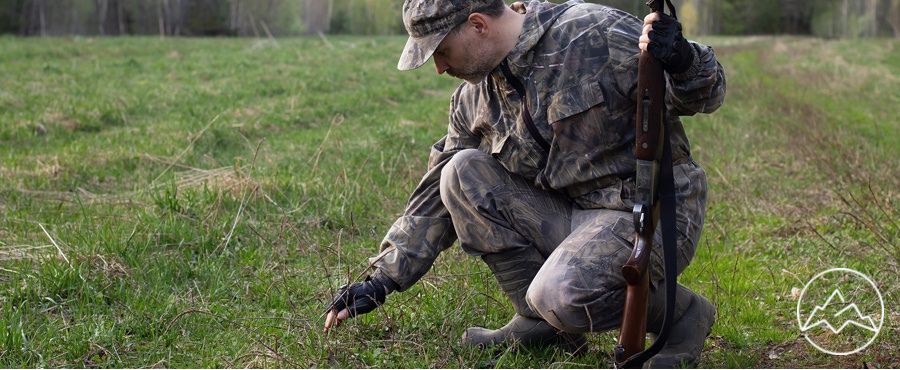Our ancestors roamed the prairies, tracked their next meals, and migrated with herds. Recognizing animal tracks used to be a crucial survival skill. Animal footprints can tell you a lot. You can learn what kind of animals are in the vicinity, where they are headed, and how long ago they left the area.
Learning to identify animal tracks is a key skill for a hunter or trapper. Let’s jump into some tips to identify animal tracks.
#1 – Look for the right terrain
You can usually spot animal tracks in soft terrain. Think about the times in your life when you have noticed animal footprints, and they’ll probably be in one of these conditions:
- Snow: Soft, powdery snow creates excellent conditions for spotting animal tracks.
- Mud: Soft terrain, like mud, is one of the most common areas to find animal footprints.
- Sand: Firm sand is especially useful. You can find tracks like these by water sources.
Knowing where to look when animal tracking is the first step in identifying animals’ behaviors around you.
#2 – Observe the walking pattern
The way an animal walks tells us a lot about them. Here are a few types of walking patterns to look for:
- S-pattern: Efficient walkers conserve energy as they stride. Their back paw lands in the same area their front one fell. This creates an S-pattern to their tracks. Examples of animals that are efficient walkers are moose, fox, deer, coyote, and bobcats.
- Waddlers: When you watch these animals in the wild, you tend to notice they move one side of their body at a time. This leaves a track with four feet. Common waddlers are bears, porcupines, beavers, raccoons, muskrats, and skunks.
- Bounders: These animals form two prints side-by-side. The animal puts its back feet in the same position as its front feet. Typical bounders include otters and weasels.
- Hoppers: These animals have tracks that show the back feet slightly ahead of the front. Their front feet land first, and their back feet land slightly ahead as leverage to propel forward. Standard hoppers are rabbits, mice, and chipmunks.
#3 – Pay attention to the track characteristics
Once you know where to look and examine tracking patterns, it’s time to get on the ground and study characteristics:
- Size: Look at the length and width of the print. Size can tell you if you’re dealing with a young animal or an adult.
- Toes: Counting the number of toes is a significant indicator of the type of animal you’re tracking.
- Claw prints: Claw prints can help determine the type of animal as well. Canines and other predators tend to leave claw prints.
- Depth: The depth of a footprint can help you assess the size of an animal.
- Front/rear: Some animals may have different-sized paws on the front and hind feet.
#4 – Identifying bear tracks
Bear tracks are the easiest to spot. They have big feet with five toes and a rounded heel. Here is how you can tell the difference between Grizzly and Black bears:
- Grizzly Bear: A grizzly bear will have tracks with more extended claws with toes close together.
- Black Bear: A black bear will have shorter claws and toes that are spread wider apart.
#5 – Identifying canine tracks
Canine prints are easy to identify. They have four toes and a concave heel pad. The toes point forward and are close together. Claw marks are typically visible. Here’s how you can determine the type of canine you’re dealing with:
- Dog: It’s easy to mistake dogs for other animals because they vary in size. One difference is that dog tracks tend to follow an S-pattern, while wild animals walk straight.
- Fox: Foxes have the smallest print of canines, with soft steps.
- Coyote: Coyotes tend to walk in a straight pattern. Their prints are smaller than wolves.
- Wolf: Wolves have the largest paws. Their gait is more prominent, and they walk in a straight line.
#6 – Identifying feline tracks
Felines have four toe prints with heel pads that look like clouds with three bumps that form a C-shape. Here’s how you can tell different felines apart:
- Cat: The smallest of the feline prints, domestic cats follow more of an S-pattern in their walk.
- Bobcat: Larger than the domestic cat, bobcat tracks tend to get confused with a coyote or fox. One giveaway is that the prints tend to not have claws.
- Linx: Although they are smaller animals, their tracks are large for their size. Their tracks have a shallower depth compared to cougar tracks.
- Cougar: The largest of the feline tracks, they are about the size of a domestic dog.
#7 – Identifying large hoof tracks
The animals associated with these prints are deer, elk, moose, bison, and cows. Here’s how you can spot the difference:
- Moose: The largest of the hooved animals have
Wrapping up
Our ancestors once depended on animal tracks for survival. With a little practice, we can remember our roots to hunt, trap, or even camp in the wild. You may also be interested in this video that covers tracking based on animal droppings, or scat.



